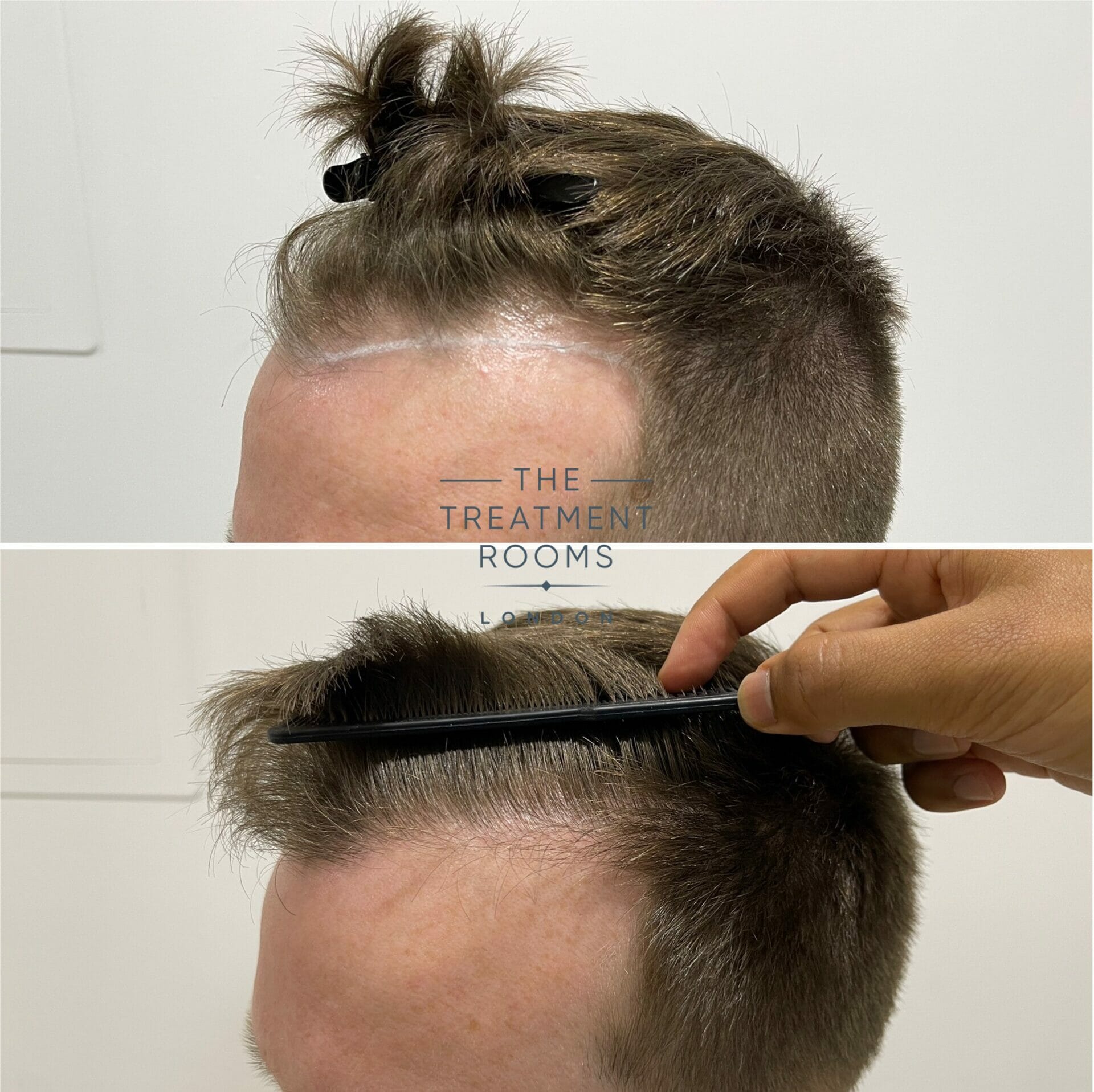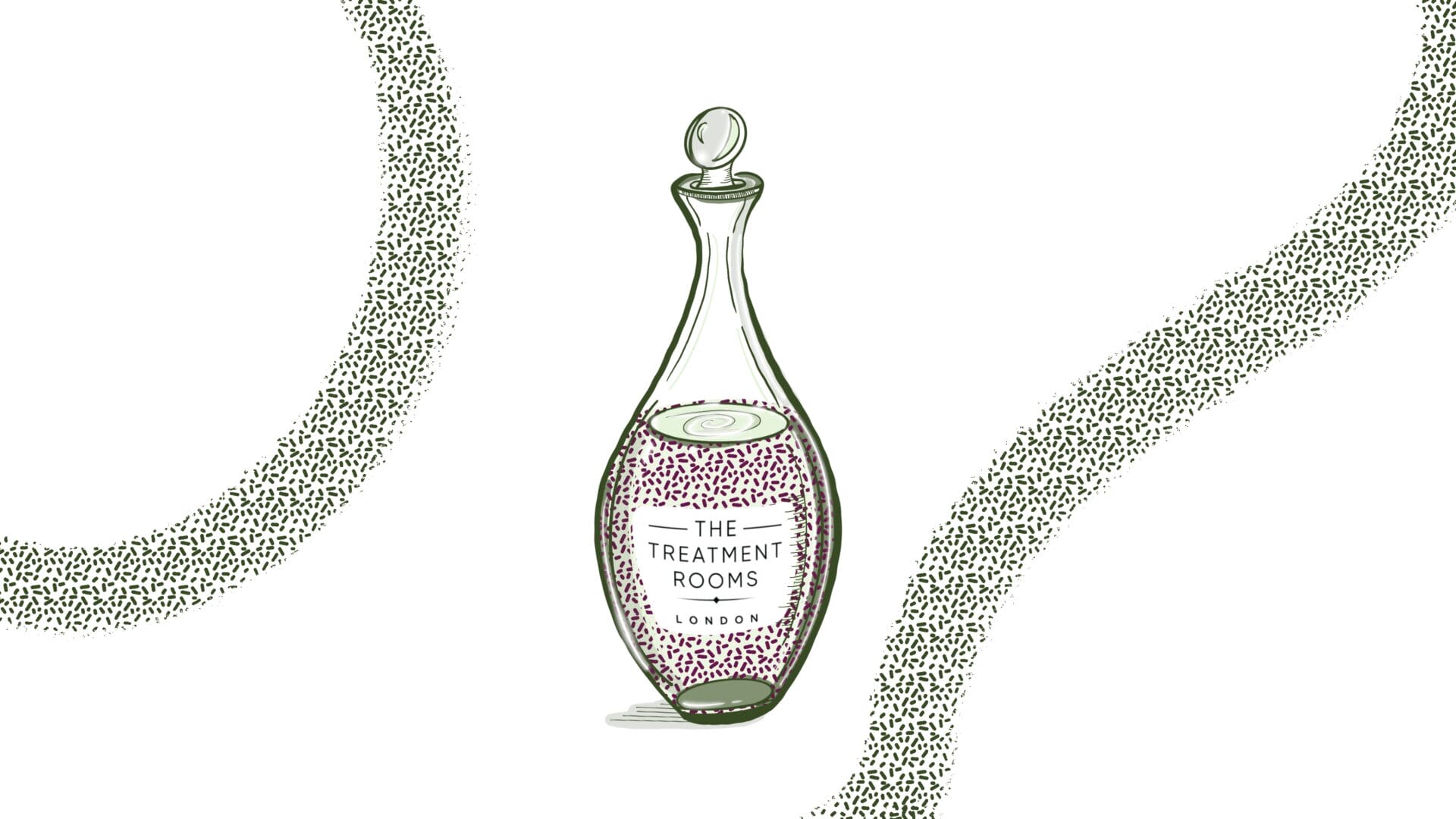At The Treatment Rooms London, we often get asked “When can I get back to work after my hair transplant?”. It’s a common question because many patients are worried about the hair transplant recovery process and having obvious signs of surgery. The answer depends on what the patient normally does for work and advice can generally be split between 2 main principles:
- Whether you can work from home
- If you have to go back into the office
Working from home
If you can work from home, you can go back to work the day after your hair transplant procedure. If possible, it is advisable to wait until the 5th day before going back to remote working as this will allow enough recovery time. This is at a time when you have fewer signs of surgery and your hairs aren’t so fragile in your recipient area.
At 1 week post surgery you should have minimal signs of surgery (little to no signs of scabs) in the areas we have operated in. An example of how you will look is shown below. 
Returning back to the office
If you have to go back into the office to work, you should take at least 10 days off work to ensure you have fully recovered and don't have visible signs of surgery (redness and scabbing). This is demonstrated below.

The gentleman above underwent surgery to his frontal hairline. He works with clients in person and was keen to return to work after 2 weeks. His photos from left to right demonstrate: pre-surgery hairline, immediately after surgery and 10 days after surgery. You can see that when he returns to work he will have a mildly red area where he has had surgery. He had an unshaven hair transplant so he can comb forward his long hair and conceal the front. We specialise in being able to offer this type of surgery to patients looking to get back to work and have the extra discretion.
Tips for returning to work after a hair transplant
If you have to return to work as soon as possible after your transplant, it’s important to use these tips and tricks to help you stay safe and recover quickly. We recommend:
- Rest as much as possible
- Allow yourself time to heal
- Spray your scalp with the solution we provide
- You may need to wear a cap to protect your hair and conceal your transplant
- Try and avoid direct sunlight
- If possible, wait 10- 14 days before returning to work
This video showcases a patient who underwent surgery in our clinic and returned to work 10 days following his procedure. The video starts immediately when he starts to talk about his recovery and going back to work following his hair transplant
What to expect after hair transplant surgery
Waiting for your hair to grow back can be a long process that is both exciting and frustrating. Most patients don’t have any new growth in the first 2-3 months, so do not be disheartened if you cannot see any growth at first.
Recovery from an FUE hair transplant is relatively quick as the incisions made are sub-millimeter. During the first 3 days, you may experience some swelling or discomfort but this will soon start to fade. Initially, you will be left with small hairs delicately placed in your recipient area. You will have redness in the area we have operated in and some scabs where grafts have been placed. These obvious signs of surgery will start to fade away in 5-7 days following surgery. Whilst in the recovery phase, some hairs may fall out but do not be alarmed, this is a normal part of the process. After 3-4 months, most patients will start to see a difference in hair growth.
With the growth of your new implanted hair grafts and the healing of the donor site, there are a number of things to consider especially before returning to work. Patients must follow the aftercare and recovery advice given to them by their surgeon after the procedure. At our clinic, our Surgeons are always available for a follow-up, to answer any further questions you may have as your new hair starts to grow.
If you have any further questions on what to expect after a hair transplant surgery, please visit our aftercare and recovery page.
When can I go back to work?
You can go back to work after 5 days following your hair transplant. This is at a time in your recovery when you have fewer signs of surgery and your hairs aren’t so fragile in the recipient area. Ideally, if you have the choice, you should aim to go back to work after 10 days following your hair transplant. At this point, you will have fully recovered from surgery and have minimal signs of redness and scabbing.
Patients must consider what type of work they do when deciding when to go back to work. We recommend you do not expose your head to direct strong sunlight for 2 weeks following your procedure. This is because direct sunlight can cause sunburn and damage your newly implanted hairs. For this reason, if you work in the sun, you may wish to wear a cap or a hat.
Another consideration is for those who need to wear a tight-fitting hat at work. A tightly fitted hat that sits on top of your newly implanted hairs risks compromising the delicately placed hairs. In these circumstances, we recommend you take 2 weeks off work.
What type of work do you do?
Patients must consider what type of work they do when deciding when to go back to work. We recommend you do not expose your head to direct sunlight for 2 weeks following your procedure. This is because direct sunlight can cause sunburn and damage your newly implanted hairs. For this reason, if you work in the sun, you may wish to wear a cap or a hat.
Another consideration is for those who need to wear a tight-fitting hat at work. A tightly fitted hat that sits on top of your newly implanted hairs risks compromising the delicately placed hairs. In these circumstances, we recommend you take 2 weeks off work.
Hair transplant considerations
The main considerations you need to think about when returning to work are:
- How long after hair transplant are grafts secure?
- Hair transplant side effects
- How to hide your hair transplant
- The day when you finish spraying your recipient site every 30 minutes
Each of these points is incredibly important when it comes to deciding when to have your hair transplant and fitting it into your work schedule. Below we go into more detail about these considerations.
How long after hair transplant are grafts secure?
Regardless of where you work, you will need to be extra careful not to dislodge any newly implanted grafts. It takes 2 weeks for newly implanted grafts to fully embed into the scalp following a hair transplant. This means that if you are worried about going to work and dislodging hairs, you will need to wait until 14 days have passed since your operation.
At our clinic, we explain that the first 5 days following a hair transplant are crucial. The hairs are very delicate and any minimal contact on the scalp can dislodge them. For this reason, we advise all patients to take a rest for 5 days following their transplant. This can extend to 10-11 days if 5 days are taken off in between 2 weekends. As a result, by the time you get back to work your hair will be well on the way to “taking root”!
For more information, please read our blog on: how long does it take after a hair transplant for grafts to become secure?
Hair transplant side effects
During the recovery process, patients will experience some mild to moderate side effects due to the nature of the hair transplant procedure. Although FUE hair transplants are less invasive than a FUT procedure, on account of the smaller incisions being made, people may still encounter potential side effects; so it’s important to consider them, especially when returning to work.
Below, we have listed the common side effects of an FUE hair transplant for patients to look out for. During your recovery, it is important to keep an eye out for these reactions and deal with them appropriately. These include:
- Swelling
- Bleeding
- Itching
- Infections
- Crusting
- Shock loss of the surrounding and transplanted hair (temporary)
The pain may also start to get worse on the evening of the surgery but it should not be severe. If you start to experience severe or ongoing side effects please contact your surgeon as soon as possible. For more information, please visit our hair transplant side effects page.
How to hide your hair transplant
This is a common worry. When they go back to work, many patients don’t want anyone to know that they have had a hair transplant. People can notice someone has had a hair transplant for the following reasons:
- Short hair cut on the back and sides
- Small scabs in the newly implanted area
- Redness in the donor and recipient areas
Short hair cut on the back and sides
To carry out an FUE hair transplant many patients will be required to shave their on the back and sides of the head to a grade 0. This can take 7-10 days to grow to a length that isn’t perceived as too short for work. So if you are worried about having too short a haircut following your hair transplant, we advise waiting 7-10 days before going back to work.
Small scabs in the newly implanted area
In the first 1-4 days after hair transplant surgery, you will have noticeable small scabs where your newly implanted grafts are. When you finally get to wash your head on the 4th day after surgery these small scabs will begin to wash away. By the 7th-10th day of washing, these small scabs should have washed away entirely. So if you were worried about going back to work and someone seeing small scabs from surgery you should wait 7-10 days before returning to work.
Redness in the donor and recipient areas
After your hair transplant, you will find the back and the front of your head will be slightly red. This is because the tiny cuts made by your hair transplant surgeon heal with a degree of redness. If you have light coloured skin this redness is more obvious than darker coloured skin. As a result, this redness may be more noticeable for longer.
As a general rule of thumb, the redness tends to last 10-14 days. It can rarely last 6-8 weeks after hair transplant surgery especially if you have lighter coloured skin. If you were worried about redness being noticeable after surgery then we advise waiting 2 weeks before going back to work.
However, if you have an unshaven hair transplant you should be able to comb over and conceal any red areas, therefore hiding any signs that you have undergone surgery. This means that if you wanted to get back to work earlier after your hair transplant having an unshaven procedure could be of benefit for you.
The day when you finish spraying your recipient site every 30 minutes
You should rest following your hair transplant for 5 days as you will be spraying your newly implanted hairs regularly (every 30 minutes). You stop spraying on the 5th day after your hair transplant. After this, you may wish to go back to work as you won’t be required to spray regularly from then on.

Are you looking to have a hair transplant?
If you are looking to have a hair transplant and you are still wondering about when you can go back to work, feel free to see us in the clinic. Our surgeons would be happy to go through your treatment options, as well as discuss the hair transplant aftercare and recovery programme and explain when would be the best time for you to go back to work.
If you do have any questions or queries, or you are interested in booking a consultation, please get in touch with The Treatment Rooms London.
Authored by
Reviewed by
FUE HAIR TRANSPLANT REVIEWS
Latest News
Does Rosemary Oil Work for Hair Loss?
July 16, 2024
A Summary: Does Rosemary Oil Work for Hair Loss? Understanding Rosemary Oil: Extracted from the rosemary plant,…
Zinc supplements for hair loss – Do they work?
July 15, 2024
Quick Summary: Zinc Supplements for Hair Loss At The Treatment Rooms London, we understand the significant impact…
Polycystic Ovary Syndrome (PCOS) and Hair Loss: What You Need to Know
July 10, 2024
Quick Summary: Polycystic Ovary Syndrome (PCOS) and Hair Loss – What You Need to Know Excessive hair…
Book A Consultation








